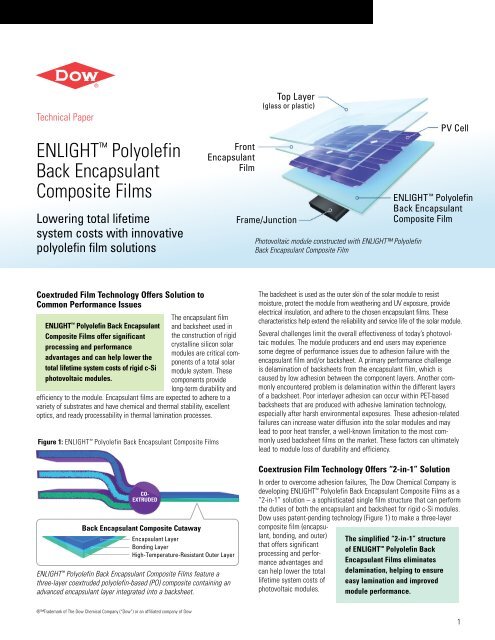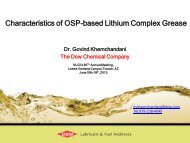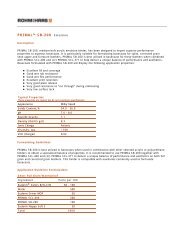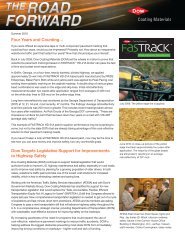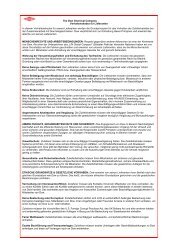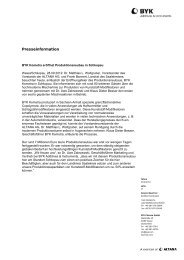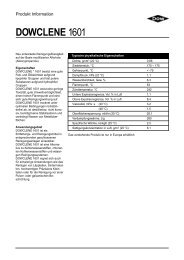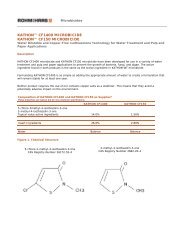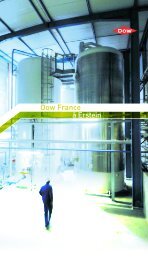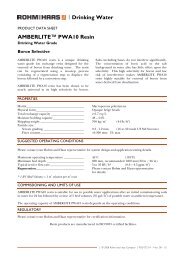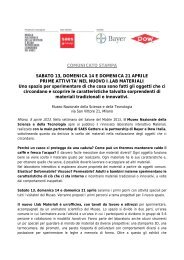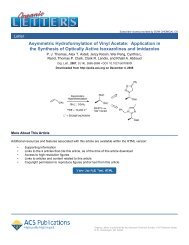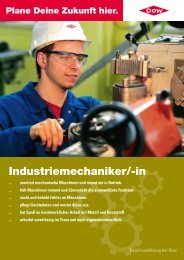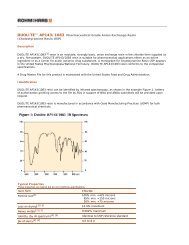ENLIGHT™ Polyolefin Back Encapsulant Composite Films
ENLIGHT™ Polyolefin Back Encapsulant Composite Films
ENLIGHT™ Polyolefin Back Encapsulant Composite Films
You also want an ePaper? Increase the reach of your titles
YUMPU automatically turns print PDFs into web optimized ePapers that Google loves.
Technical Paper<br />
ENLIGHT <strong>Polyolefin</strong><br />
<strong>Back</strong> <strong>Encapsulant</strong><br />
<strong>Composite</strong> <strong>Films</strong><br />
Lowering total lifetime<br />
system costs with innovative<br />
polyolefin film solutions<br />
Coextruded Film Technology Offers Solution to<br />
Common Performance Issues<br />
ENLIGHT <strong>Polyolefin</strong> <strong>Back</strong> <strong>Encapsulant</strong><br />
<strong>Composite</strong> <strong>Films</strong> offer significant<br />
processing and performance<br />
advantages and can help lower the<br />
total lifetime system costs of rigid c-Si<br />
photovoltaic modules.<br />
CO-<br />
EXTRUDED<br />
<strong>Back</strong> <strong>Encapsulant</strong> <strong>Composite</strong> Cutaway<br />
Front<br />
<strong>Encapsulant</strong><br />
Film<br />
<strong>Encapsulant</strong> Layer<br />
Bonding Layer<br />
High-Temperature-Resistant Outer Layer<br />
®Trademark of The Dow Chemical Company (“Dow”) or an affiliated company of Dow<br />
The encapsulant film<br />
and backsheet used in<br />
the construction of rigid<br />
crystalline silicon solar<br />
modules are critical components<br />
of a total solar<br />
module system. These<br />
components provide<br />
long-term durability and<br />
efficiency to the module. <strong>Encapsulant</strong> films are expected to adhere to a<br />
variety of substrates and have chemical and thermal stability, excellent<br />
optics, and ready processability in thermal lamination processes.<br />
Figure 1: ENLIGHT <strong>Polyolefin</strong> <strong>Back</strong> <strong>Encapsulant</strong> <strong>Composite</strong> <strong>Films</strong><br />
ENLIGHT <strong>Polyolefin</strong> <strong>Back</strong> <strong>Encapsulant</strong> <strong>Composite</strong> <strong>Films</strong> feature a<br />
three-layer coextruded polyolefin-based (PO) composite containing an<br />
advanced encapsulant layer integrated into a backsheet.<br />
Top Layer<br />
(glass or plastic)<br />
Frame/Junction<br />
Photovoltaic module constructed with ENLIGHT <strong>Polyolefin</strong><br />
<strong>Back</strong> <strong>Encapsulant</strong> <strong>Composite</strong> Film<br />
PV Cell<br />
ENLIGHT <strong>Polyolefin</strong><br />
<strong>Back</strong> <strong>Encapsulant</strong><br />
<strong>Composite</strong> Film<br />
The backsheet is used as the outer skin of the solar module to resist<br />
moisture, protect the module from weathering and UV exposure, provide<br />
electrical insulation, and adhere to the chosen encapsulant films. These<br />
characteristics help extend the reliability and service life of the solar module.<br />
Several challenges limit the overall effectiveness of today’s photovoltaic<br />
modules. The module producers and end users may experience<br />
some degree of performance issues due to adhesion failure with the<br />
encapsulant film and/or backsheet. A primary performance challenge<br />
is delamination of backsheets from the encapsulant film, which is<br />
caused by low adhesion between the component layers. Another commonly<br />
encountered problem is delamination within the different layers<br />
of a backsheet. Poor interlayer adhesion can occur within PET-based<br />
backsheets that are produced with adhesive lamination technology,<br />
especially after harsh environmental exposures. These adhesion-related<br />
failures can increase water diffusion into the solar modules and may<br />
lead to poor heat transfer, a well-known limitation to the most commonly<br />
used backsheet films on the market. These factors can ultimately<br />
lead to module loss of durability and efficiency.<br />
Coextrusion Film Technology Offers “2-in-1” Solution<br />
In order to overcome adhesion failures, The Dow Chemical Company is<br />
developing ENLIGHT <strong>Polyolefin</strong> <strong>Back</strong> <strong>Encapsulant</strong> <strong>Composite</strong> <strong>Films</strong> as a<br />
“2-in-1” solution – a sophisticated single film structure that can perform<br />
the duties of both the encapsulant and backsheet for rigid c-Si modules.<br />
Dow uses patent-pending technology (Figure 1) to make a three-layer<br />
composite film (encapsu-<br />
lant, bonding, and outer)<br />
that offers significant<br />
processing and performance<br />
advantages and<br />
can help lower the total<br />
lifetime system costs of<br />
photovoltaic modules.<br />
The simplified “2-in-1” structure<br />
of ENLIGHT <strong>Polyolefin</strong> <strong>Back</strong><br />
<strong>Encapsulant</strong> <strong>Films</strong> eliminates<br />
delamination, helping to ensure<br />
easy lamination and improved<br />
module performance.<br />
1
Addressing Adhesion Issues<br />
The coextrusion process used to make ENLIGHT <strong>Polyolefin</strong> <strong>Back</strong><br />
<strong>Encapsulant</strong> <strong>Composite</strong> <strong>Films</strong> has distinct advantages over the current<br />
adhesive lamination process. The technology that creates this three-layer<br />
composite allows the bonding layer to wet, interdiffuse, entangle, and<br />
crystallize with the encapsulant and outer layers, resulting in uniform melt<br />
bonding and high bond strength across all areas during film/foil manufacturing.<br />
The bonds between the film layers exhibit lamellar entanglement<br />
with very diffuse interfacial boundaries provided by the highly compatible<br />
polyolefin (PO) bonding layer of the coextruded structure (Figure 2).<br />
The integrity of the bonding layer significantly increases interlayer bond<br />
strength, reducing the potential for interlayer adhesion failures. This<br />
simplified “2-in-1” structure helps overcome delamination that can occur<br />
between separate encapsulant and backsheet layers and eliminates<br />
potential incompatibility between the encapsulant and the backsheet,<br />
helping to ensure easy lamination and improved module performance.<br />
ENLIGHT <strong>Polyolefin</strong> <strong>Back</strong> <strong>Encapsulant</strong> <strong>Composite</strong> (BEC) <strong>Films</strong> have<br />
excellent adhesion to different types of front encapsulant, either EVA<br />
or polyolefin. The high adhesion to the front encapsulant is maintained<br />
even after severe thermal treatments (Table 1). Due to the advantages<br />
offered by Dow’s coextruded polyolefin film technology, the excellent<br />
adhesion between the encapsulant layer in ENLIGHT BEC <strong>Films</strong> and<br />
the high-temperature-resistant polyolefin outer layer was achieved and<br />
maintained even after 4,000 hours of damp heat and 400 thermal cycles.<br />
Figure 2: Lamellar Entanglement of ENLIGHT <strong>Polyolefin</strong> <strong>Back</strong><br />
<strong>Encapsulant</strong> <strong>Composite</strong> <strong>Films</strong><br />
2<br />
<strong>Polyolefin</strong> Bonding Layer<br />
<strong>Polyolefin</strong> <strong>Encapsulant</strong> Layer<br />
Trademark of The Dow Chemical Company (“Dow”) or an affiliated company of Dow<br />
Ratio should be:<br />
Outer = 40%<br />
Bonding = 10%<br />
Encap = 50%<br />
Table 1: Adhesion properties before and after thermal treatment<br />
Adhesion N/cm<br />
N/cm after<br />
damp heat 1<br />
N/cm after<br />
thermal cycle 2<br />
Interlayer >15 to destruct >15 to destruct >15 to destruct<br />
Front <strong>Encapsulant</strong><br />
Layer<br />
1 Temperature: 85°C; Humidity: 85%; 4,000 hrs<br />
2 -40 to 90°C; 400 cycle<br />
>60 to destruct >60 to destruct >60 to destruct<br />
Coextruded <strong>Composite</strong> Film Structure Offers<br />
Additional Advantages<br />
In addition to solving adhesion issues, the electrical properties of<br />
ENLIGHT BEC <strong>Films</strong> are advantaged since coextrusion eliminates<br />
voids or bubbles within or in between the backsheet and encapsulant.<br />
Partial discharge can range from the requirement of 1,000 V to >2000 V,<br />
offering module manufacturers the ability to comply with high voltage<br />
requirements. The dielectric strength meets or outperforms some of the<br />
most widely-used incumbent offerings on the market.<br />
ENLIGHT <strong>Polyolefin</strong> <strong>Back</strong> <strong>Encapsulant</strong> <strong>Composite</strong> <strong>Films</strong> offer excellent levels<br />
of moisture barrier protection, consistent with the proven performance of<br />
ENLIGHT <strong>Polyolefin</strong> <strong>Encapsulant</strong> <strong>Films</strong> that are used in rigid c-Si modules.<br />
The Water Vapor Transmission Rates of ENLIGHT <strong>Polyolefin</strong> <strong>Films</strong> are<br />
significantly lower than EVA films. 1 All components and interlayer bonds<br />
of the composite structure are highly moisture stable, unlike PET-based<br />
backsheets, and all layers have excellent moisture barrier when compared<br />
to typical encapsulant and backsheet materials. 2<br />
<strong>Polyolefin</strong> Outer Layer<br />
<strong>Polyolefin</strong> Bonding Layer<br />
<strong>Polyolefin</strong> <strong>Encapsulant</strong> Layer<br />
A cross-section micrograph between the polyolefin encapsulant<br />
layer and the polyolefin bonding layer demonstrates the<br />
lamellar entanglement features of ENLIGHT <strong>Polyolefin</strong><br />
<strong>Back</strong> <strong>Encapsulant</strong> <strong>Composite</strong> <strong>Films</strong>.<br />
1 Based on Dow testing when compared to some EVA-based materials. Data available upon request<br />
2 Based on Dow testing when compared to some commonly-used encapsulant and backsheet materials.<br />
Data available upon request.
The composite structure was designed to provide low temperature<br />
toughness down to -40°C. ENLIGHT BEC <strong>Films</strong> also offer high levels of<br />
protection from UV exposure and long-term heat aging.<br />
<strong>Polyolefin</strong>-based films possess properties that can help reduce Potential<br />
Induced Degradation (PID). When ENLIGHT <strong>Polyolefin</strong> <strong>Back</strong> <strong>Encapsulant</strong><br />
<strong>Composite</strong> <strong>Films</strong> are used in module designs containing a polyolefinbased<br />
top encapsulant film (such as ENLIGHT <strong>Polyolefin</strong> <strong>Encapsulant</strong><br />
Film), they can help contribute to higher levels of PID resistance.<br />
ENLIGHT BEC <strong>Films</strong> can be used with different top encapsulant materials<br />
such as EVA or polyolefin. Using both ENLIGHT BEC Film for the<br />
back component as well as ENLIGHT <strong>Polyolefin</strong> <strong>Encapsulant</strong> Film for<br />
the top encapsulant can lead to significant processing and performance<br />
improvements and help reduce total lifetime system costs.<br />
“These coextruded polyolefin films offer broader design<br />
flexibility, allowing the materials to be customized to fit exact<br />
module specifications and needs. By combining two separate<br />
components into one, ENLIGHT <strong>Polyolefin</strong> <strong>Back</strong> <strong>Encapsulant</strong><br />
<strong>Composite</strong> <strong>Films</strong> offer excellent module protection due to the<br />
elimination of delamination, improved electrical insulation, and<br />
higher levels of moisture resistance.”<br />
Dr. Burçak Conley, Application Development Specialist, Photovoltaics Business<br />
“With this new development in the product line for ENLIGHT <br />
<strong>Polyolefin</strong> <strong>Films</strong>, Dow can leverage our technical knowledge<br />
in coextrusion and apply the proven performance of ENLIGHT<br />
<strong>Polyolefin</strong> <strong>Encapsulant</strong> <strong>Films</strong> into new application areas. The use<br />
of ENLIGHT <strong>Polyolefin</strong> <strong>Back</strong> <strong>Encapsulant</strong> <strong>Composite</strong> <strong>Films</strong> helps<br />
reduce materials and inventories, and can result in significantly<br />
increased production efficiencies. The regional availability of all<br />
ENLIGHT <strong>Polyolefin</strong> <strong>Films</strong> can also help our customers improve<br />
working capital management. Overall, the use of this innovative<br />
“2-in-1” encapsulant plus backsheet composite can lead to<br />
significant performance and productivity improvements and help<br />
reduce total lifetime system costs for PV modules.”<br />
Friedrich von Rechteren, Global Business Development Manager, Photovoltaics Business<br />
Trademark of The Dow Chemical Company (“Dow”) or an affiliated company of Dow<br />
Dow is dedicated to finding technologies<br />
that harness the power of the sun and<br />
bring energy to use in many different<br />
ways – through solar farms, rigid and<br />
flexible photovoltaic solar modules, and<br />
more. In addition to ENLIGHT <strong>Polyolefin</strong><br />
<strong>Back</strong> <strong>Encapsulant</strong> <strong>Composite</strong> <strong>Films</strong>, Dow<br />
offers proven performance and production<br />
efficiencies to manufacturers of rigid c-Si<br />
modules with its line of ENLIGHT <strong>Polyolefin</strong><br />
<strong>Encapsulant</strong> <strong>Films</strong>. The Company also<br />
makes ADCOTE Solvent-based Adhesives<br />
and MOR-FREE Solventless Laminating<br />
Adhesives for backsheet products, electronic<br />
materials used to make photoelectric<br />
cells, polyglycol heat transfer fluids, and<br />
DOW POWERHOUSE Solar Shingles for<br />
residential use.<br />
Authors, The Dow Chemical Company, Photovoltaic Business:<br />
• Dr. Burçak Conley, Application Development Specialist<br />
• Dr. Jeff Bonekamp, Product R&D Scientist<br />
• Friedrich von Rechteren, Global Business Development Manager<br />
3
For more information on products, innovations, expertise, and other services available,<br />
please visit www.dowsolarpv.com or contact us as indicated below.<br />
North America<br />
U.S. & Canada 1-800-441-4369<br />
1-989-832-1426<br />
Mexico +1-800-441-4369<br />
Latin America<br />
Argentina +54-11-4319-0100<br />
Brazil +55-11-5188-9000<br />
Colombia +57-1-219-6000<br />
Mexico +52-55-5201-4700<br />
Europe/Middle East +800-3694-6367<br />
+31-115-672626<br />
Italy +800-783-825<br />
South Africa +800-99-5078<br />
Asia Pacific +800-7776-7776<br />
+603-7965-5392<br />
The principles of Responsible Care ® and Sustainable Development influence the production of printed literature<br />
for The Dow Chemical Company (“Dow”). As a contribution towards the protection of our environment, Dow’s<br />
printed literature is produced in small quantities and on paper containing recovered/post-consumer fiber and<br />
using 100 percent soy-based ink whenever possible.<br />
NOTICE: Any photographs of end-use applications in this document represent potential end-use applications<br />
but do not necessarily represent current commercial applications, nor do they represent an endorsement by<br />
Dow of the actual products. Further, these photographs are for illustration purposes only and do not reflect either<br />
an endorsement or sponsorship of any other manufacturer for a specific potential end-use product or application,<br />
or for Dow, or for specific products manufactured by Dow.<br />
NOTICE: No freedom from infringement of any patent owned by Dow or others is to be inferred. Because use<br />
conditions and applicable laws may differ from one location to another and may change with time, the Customer<br />
is responsible for determining whether products and the information in this document are appropriate for the<br />
Customer’s use and for ensuring that the Customer’s workplace and disposal practices are in compliance with<br />
applicable laws and other gov ernmental enactments. Dow assumes no obligation or liability for the information<br />
in this document. NO WARRANTIES ARE GIVEN; ALL IMPLIED WARRANTIES OF MERCHANTABILITY<br />
OR FITNESS FOR A PARTICULAR PURPOSE ARE EXPRESSLY EXCLUDED.<br />
NOTICE: If products are described as “experimental” or “developmental”: (1) product specifications may not be<br />
fully determined; (2) analysis of hazards and caution in handling and use are required; (3) there is greater potential<br />
for Dow to change specifications and/or discontinue production; and (4) although Dow may from time to time<br />
provide samples of such products, Dow is not obligated to supply or otherwise commercialize such products for<br />
any use or application whatsoever.<br />
NOTICE REGARDING MEDICAL APPLICATION RESTRICTIONS: Dow will not knowingly sell or sample any product<br />
or service (“Product”) into any commercial or developmental application that is intended for:<br />
a. long-term or permanent contact with internal bodily fluids or tissues. “Long-term” is contact which exceeds<br />
72 continuous hours;<br />
b. use in cardiac prosthetic devices regardless of the length of time involved (“cardiac prosthetic devices”<br />
include, but are not limited to, pacemaker leads and devices, artificial hearts, heart valves, intra-aortic<br />
balloons and control systems, and ventricular bypass-assisted devices);<br />
c. use as a critical component in medical devices that support or sustain human life; or<br />
d. use specifically by pregnant women or in applications designed specifically to promote or interfere with<br />
human reproduction.<br />
Dow requests that customers considering use of Dow products in medical applications notify Dow so that<br />
appropriate assessments may be conducted.<br />
Dow does not endorse or claim suitability of its products for specific medical applications. It is the responsibility<br />
of the medical device or pharmaceutical manufacturer to determine that the Dow product is safe, lawful, and<br />
technically suitable for the intended use. DOW MAKES NO WARRANTIES, EXPRESS OR IMPLIED,<br />
CONCERNING THE SUITABILITY OF ANY DOW PRODUCT FOR USE IN MEDICAL APPLICATIONS.<br />
This document is intended for use within all geographies<br />
Published August, 2012. Printed in U.S.A.<br />
© 2012 The Dow Chemical Company<br />
® Trademark of The Dow Chemical Company (“Dow”) or an affiliated company of Dow<br />
® Responsible Care is a service mark of the American Chemistry Council.<br />
Dow is a partner in the American Chemistry Council Responsible Care initiative. Form No. 877-00334-0812 SMG<br />
SMG 12419


